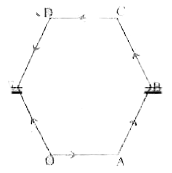Find ∣∣→a×→b∣∣ if →a=ˆi−7ˆj+7ˆk and →b=3ˆi−2ˆj+2ˆk.Solution in Tamil
The correct Answer is:C
Step by step video, text & image solution for Find |vec a xx vec b| if vec a = hat i -7 hat j + 7 hat k and vec b = 3 hat i - 2 hat j + 2 hat k. by Maths experts to help you in doubts & scoring excellent marks in Class 12 exams.
Updated on:21/07/2023Topper's Solved these Questions
- VECTOR ALGEBRABOOK - NEW JOYTHI PUBLICATIONCHAPTER - VECTOR ALGEBRAEXERCISE - ADDITIONAL QUESTIONS FOR PRACTICE 10.1
2 Videos
- VECTOR ALGEBRABOOK - NEW JOYTHI PUBLICATIONCHAPTER - VECTOR ALGEBRAEXERCISE - ADDITIONAL QUESTIONS FOR PRACTICE 10.2
13 Videos
- VECTOR ALGEBRABOOK - NEW JOYTHI PUBLICATIONCHAPTER - VECTOR ALGEBRAEXERCISE - SOLUTIONS TO NCERT TEXT BOOK EXERCISE 10.3
18 Videos
- TRIGONOMETRIC FUNCTIONSBOOK - NEW JOYTHI PUBLICATIONCHAPTER - TRIGONOMETRIC FUNCTIONSEXERCISE - QUESTIONS FROM COMPETITIVE EXAMS
134 Videos
Similar Questions
In the figure which vectors are
(i) equal (ii) collinear (iii) coinitial

View SolutionCompute the magnitude of the following vectors and identify the unit vector.
→a=2ˆi−3ˆj+5ˆk
View SolutionFind the angle between two vectors →a and →b with magnitudes √3 and 2, respectivey having →a.→b=√6.
View SolutionIf A+B+C=90∘ then
cotA+cotB+cotCcotAcotBcotC =
View SolutionLet →a=ˆj−ˆk and →c=ˆi−ˆj−ˆk . Then vector →b satisfying →a×→b+→c=→0 and →a.→b=3 is (1) 2→i−→j+2→k (2) ˆi−ˆj−2ˆk (3) ˆi+j−2ˆk (4) −ˆi+ˆj−2ˆk
View SolutionIf →A=4ˆI+6ˆj−3ˆk and →B=−2ˆI−5ˆj+7ˆk, find the angle between →Aand→B.
View SolutionIf vec A=hat I + 2 hat j -3 hat k , vec B =2 hat I -hat j + hat k and vec Chat I -3 hat j + 2 hat k , then find vec A xx ( vec B xx vec C).
View SolutionIf →a=ˆi+ˆj+2ˆk and →b=3ˆi+2ˆj−ˆk, find the value of(→a+3→b). (2→a−→b).
View SolutionIf vec(a) = 3 hat(i) + 2 hat(k) , vec(b) = 3hat(j) - hat(k) and vec(c ) = hat(i) + hat(j) + hat(k) . Find ( vec(a) xx vec(b)). vec(c ) .
View SolutionFind the unit vectors perpendicular to both →a and →b when
(i) →a=3ˆi+ˆj−2ˆk and →b=2ˆi+3ˆj−ˆk
(ii) →a=ˆi−2ˆj+3ˆk and →b=ˆi+2ˆj−ˆk
(iii) →a=ˆi+3ˆj−2ˆk and →b=−ˆi+3ˆk
(iv) →a=4ˆi+2ˆj−ˆk and →b=ˆi+4ˆj−ˆk
View SolutionLet →a=2ˆi−2ˆj+ˆk,→b=ˆj−ˆkand→c=−ˆi+3ˆj+2ˆk be three given vectors .Find
(→a+→b)×(→b−→c)
View SolutionIf →a=ˆi+ˆj−ˆk,→b=2ˆi−2ˆj+ˆkand→c=3ˆi+2ˆj−2ˆk show that ,
→a.(→b+→c)=→a.→b+→a.→c
View SolutionFind →a.(→b×→c), if →a=2ˆi+ˆj+3ˆk,→b=−ˆi+2ˆj+ˆk and →c=3ˆi+ˆj+2ˆk.
View SolutionFind ∣∣→a×→b∣∣, if →a=ˆi−7ˆj+7ˆkand →b=3ˆi−2ˆj+2ˆk
View SolutionFind ∣∣→a×→b∣∣ , if →a=ˆi−7ˆj+7ˆkand→b=3ˆi−2ˆj+2ˆk.
View Solution
